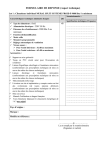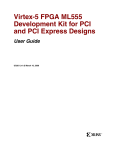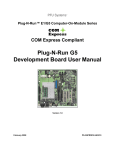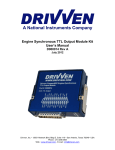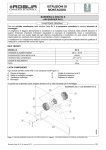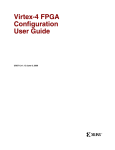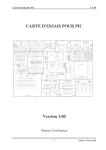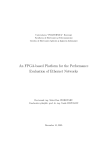Download Manual
Transcript
AK 2007-06/1 Universität Mannheim Lehrstuhl Informatik V Insitut für Technische Informatik User Manual Document Version: Document ID: Document Date: Document Status: 1.0 AK 2007-06/01 1899-12-30 Draft Abstract User manual for the re-configurable accelerator MPRACE-2. Institutes and Authors: Mannheim University: A. Kugel 0 00 page 1 0 0 Version/Issue: 10/6 Table 1 Document Change Record Title: MPRACE-2 User Manual ID: AK 2007-06/01 Version Issue Date Comment 1 1 2007-06-19 Birth 1 2 2007-09-07 Updates 1 4 2007-11-06 More updates 1 5 2008-03-28 Clock usage 1 6 2008-04-09 Pin infos and K-characters 1 7 2010-09-13 Test pin info added page 2 0 ATLAS TDAQ 0 Version/Issue: 10/6 Contents 1INTRODUCTION.........................................................................................5 1.1GLOSSARY, ACRONYMS AND ABBREVIATIONS...................................................5 1.2REFERENCES....................................................................................................5 2BOARD DESCRIPTION................................................................................5 3CONFIGURATION.......................................................................................7 3.1JTAG CONFIGURATION.....................................................................................7 3.1.1CPLD configuration....................................................................................................7 3.1.2FPGA configuration....................................................................................................7 4POWER-ON CONFIGURATION....................................................................8 5PARALLEL CONFIGURATION....................................................................10 6LED BLOCK...............................................................................................11 7CLOCK RESSOURCES................................................................................11 8CONTROL CPLD........................................................................................12 8.1SWITCHES......................................................................................................12 9BRIDGE FPGA...........................................................................................12 9.1FPGA..............................................................................................................12 9.2SDRAM...........................................................................................................12 9.3ETHERNET......................................................................................................12 9.4SERIAL PORT..................................................................................................12 9.5CPLD INTERFACE............................................................................................13 9.6FLASH INTERFACE..........................................................................................13 9.7PROGRAMMABLE CLOCKS................................................................................13 9.8PCIE / PCI-X...................................................................................................13 10MAIN FPGA............................................................................................14 10.1SRAM BANKS................................................................................................14 10.2DRAM BANK..................................................................................................14 10.3MEZZANINE INTERFACE................................................................................14 10.3.1Interface signals....................................................................................................14 10.3.2Power supply........................................................................................................14 10.4BOARD-TO-BOARD INTERFACE......................................................................14 11REFERENCE DESIGNS............................................................................15 11.1DESIGN RULES..............................................................................................15 11.2CONFIGURATION..........................................................................................15 11.2.1CfgTest ................................................................................................................15 12APPENDIX..............................................................................................16 12.1MGT NUMBERING SCHEME............................................................................16 page 3 0 0 Version/Issue: 10/6 12.2BRIDGE-MAIN MGT INTERCONNECT..............................................................16 12.3MGT POWERING SCHEME..............................................................................17 12.4MGT REFERENCE CLOCK 125 MHZ.................................................................17 12.5MGT LINE RATE SELECTION..........................................................................18 12.6MGT K-CHARACTERS.....................................................................................19 12.7LOGIC CLOCKING SCHEME............................................................................20 12.7.1Clocking overview..................................................................................................20 12.7.2Location of Clock, Reset and Test pins....................................................................20 12.7.3Test headers.........................................................................................................21 12.8ASSEMBLY DRAWINGS..................................................................................22 12.8.1Top......................................................................................................................22 12.8.2Bottom.................................................................................................................22 12.8.3Test-points............................................................................................................23 page 4 0 ATLAS TDAQ 0 Version/Issue: 10/6 1 Introduction Brief introductory text. 1.1 Glossary, acronyms and abbreviations Something else to be defined And here is the description for something else 1.2 References [1] [2] [3] [4] [5] [6] XILINX Virtex-4 datatsheet, http://direct.xilinx.com/bvdocs/publications/ds302.pdf XILINX Virtex-4 user guide, http://direct.xilinx.com/bvdocs/userguides/ug070.pdf XILINX configuration guide: http://direct.xilinx.com/bvdocs/userguides/ug071.pdf XILINX coolrunner datasheet: http://direct.xilinx.com/bvdocs/publications/ds090.pdf XILINX coolruner userguide: http://direct.xilinx.com/bvdocs/publications/ds094.pdf 2 Board description Fehler: Referenz nicht gefunden shows the block diagram of MPRACE-2. A small Virtex4FX FPGA 1.2, 1.2 implements the bridge to PCIe or PCI-X host bus. Figure 1: Block diagram page 5 0 0 Version/Issue: 10/6 It is equipped with 16MB of SDRAM, a GbE interface, a serial port and connects to the control CPLD 1.21.2. Via the CPLD the FLASH memory can be accessed, which stores configuration bitstreams and potentially boot software for the embedded processor. The main FPGA connects via 4 serial links and a parallel 32 bit interface to the bridge FPGA. The parallel interface is mainly intended for configuration purposes (SelectMAP8 or SelectMAP32), but may be used otherwise as well. The main FPGA is equipped with 2 banks of SRAM and 1 bank of DRAM, all of DDR-2 type. A set of high-speed connectors enable expansion via mezzanine boards. In addition, two (e.g. daisy-chain style) board-to-board connections can be established via serial links. Main FPGA PwrReg PwrReg PwrReg PwrReg PwrReg PwrReg Mezzanine area SRAM SRAM SRAM SRAM Bridge FPGA GbE PHY PWR RJ45 CPLD DDR2-Module FLASH Figure 1: Board sketch A sketch of the final board is shown in Figure 1 and a picture of the first version is shown in Fehler: Referenz nicht gefunden. Assembly drawings (version 2) are displayed in sections and . LED CPLD JTAG block FPGA JTAG Figure 3: MPRACE-2 (version 1) page 6 0 ATLAS TDAQ 0 Version/Issue: 10/6 3 Configuration 3.1 JTAG configuration 3.1.1 CPLD configuration Configuration of the CPLD (XC2C256) is done via JTAG, using the connector at the upper side of the board (close to main FPGA). 3.1.2 FPGA configuration JTAG configuration of the two FPGAs is done via the lower connector, close to the PCIe/PCIX connector. The FPGAs form a chain – defined by logic in the CPLD – with the main FPGA next to the TDI pin and the bridge FPGA next to the TDO pin (=> main is first device/LEFT, bridge is second device/RIGHT in JTAG chain), see Figure 4. The JTAG chain is defined by the CPLD and can be modified to include other JTAG-capable resources on the board. Figure 4: FPGA JTAG Chain page 7 0 0 Version/Issue: 10/6 4 Power-on configuration The 8MB FLASH memory provides space for 2 sets of configuration bitstreams and for PowerPC software. The memory regions are defined by the CPLD. For the MPRACE-2 prototypes which have an XC4VFX60 device as bridge care has to be taken, that the combined size of the bridge and main FPGA bitstreams does not exceed 3MB. This can normally be achieved using bitstream compression, but cannot be guaranteed for all designs. For the moment, the configuration set is selected using one of the DIP switches. However, an automatic setting using the PCI-power-available signal can also be implemented, by modification of the CPLD code. Figure 2: Prepare PROM The configuration bitstreams are loaded by the CPLD in slave-serial mode into the chain of the two FPGAs. The first device is the bridge FPGA. The top-most 2MB of the FLASH can be used for boot-code for the PowerPC in the bridge FPGA. The FLASH file has to be prepared from two bitfiles, with the BRIDGE content located at the beginning (lower address). Impact can be used to generate the content in HEX format (see below). Make sure that the proper bitstream region is selected via the switch. Click “finish” on the third screen. page 8 0 ATLAS TDAQ 0 Version/Issue: 10/6 Figure 3: Select device Figure 4: Start adding data page 9 0 0 Version/Issue: 10/6 Now add the bitfile for the BRIDGE, followed by the bitstream for the MAIN FPGA. The bitstreams should be generated with CCLK and drive DONE options (DONE pins are NOT wired-and on MPRACE-2). There are no data-file parameters (clock OK on that screen). Figure 5: Prom with data files Now click “Generate File” in the operations tab. The file will be in HEX format and needs to be converted by the download utility. 5 Parallel configuration While the bridge FPGA can only be configured through the CPLD (power-up or JTAG) the main FPGA can be configured also from a host PC through the bridge FPGA, in one of the parallel SelectMAP modes SMAP8 or SMAP32. SMAP32 mode requires a special setting in the UCF file of the FPGA project: CONFIG CONFIG_MODE=S_SELECTMAP32; or CONFIG CONFIG_MODE=S_SELECTMAP32+READBACK; The latter is required if readback or re-configuration will be used and makes the SMAP32 interface persistent. Designs compiled without this constraint have to use the SMAP8 mode 1. 1 page 10 To be confirmed 0 ATLAS TDAQ 0 Version/Issue: 10/6 6 LED Block A number of LEDs are used to display status information: 4 LEDs connect to the CPLD and two LEDs to each of the FPGAs. The LED are labelled (left to right): D5000, D5001, Figure 9: LED block LD6000, LD4001, LD4000. D5000 and 5001 are single LEDs, the others are bi-colour LEDs. The LEDs are positioned in the upper right area of the board, close to the upper JTAG connector, a shown in Fehler: Referenz nicht gefunden. LED Signal Usage D5000 Main LED0 Design dependent D5001 Main LED1 Design dependent LD6000-upper (green) Bridge LED1 Design dependent LD6000-lower (red) Bridge LED0 Design dependent LD4001-upper (green) CPLD LED3 ON if PCI power (12V) available LD4001-lower (red) CPLD LED2 On if power-up configuration in progress LD4000-upper (green) CPLD LED1 Reset completed (OFF during reset) LD4000-lower (red) CPLD LED0 Power good (normally ON) Table 2: LED block 7 Clock ressources A number of fixed and variable frequency oscillators is available on MPRACE-2. All MGT clocks, with the exception of the PCIe interface, can be derived from the dual-frequency oscillator U5004, which provides 125MHz (default) 2 or 156.25MHz, selectable via a CPLD signal. On the MAIN FPGA, the MGT clocks can alternatively be derived from the programmable clock source U5005 (see section 9.7). 2 According to the 2008 datasheet, an MGT reference clock of 125 MHz is no longer valid. In future assembly versions the 125MHz will be replaced by 250MHz. See appendix 12.4 on how to modify MGT cores generated by the XILINX tools to use 125MHz. page 11 0 0 Version/Issue: 10/6 8 Control CPLD ..\vhdl\cpld\cpld1\latex\refman.pdf 8.1 Switches All switches are defined by the CPLD. The current layout is as follows: 1 2 3 4 5 6 7 8 Off: Full chain, On: only FPGA OFF: upper FLASH offset, ON: lower FLASH offset Off: fan controlled by temperature sensor. On: fan on Off: auto config after powerup, On: no auto config Off: pci_reset used to trigger reconfiguration. ON: don't use pci reset Directly mapped to CLK_SEL input of U5004 to select 125 (0) or 156,25 MHz (1). U5001 fixed to 0 General purpose bit forwarded to bridge FPGA via bio_switch Unused Default settings are (switch 1 left most one) ON, ON, ON, OFF, ON, ON, OFF, OFF 9 Bridge FPGA 9.1 FPGA 9.2 SDRAM 9.3 Ethernet 9.4 Serial Port A small connector (P6000, next to the battery) provides two serial interfaces, one from each FPGA: 5 3 1 Bridge-RxD GND Bridge-TxD Main-TxD GND Main-RxD 6 4 2 The corresponding FPGA pins are: Main-TxD : AE21 Main-RxD : AF19 Bridge-TxD : A14 Bridge-RxD : A13 page 12 0 ATLAS TDAQ 0 Version/Issue: 10/6 To connect to the serial port of a PC, the pins must be connected to the following pins of a 9pin sub-D connector: • Bridge (MPRACE-2 -> sub-D): 5 – 3, 3 – 5, 1 – 2 • Main (MPRACE-2 -> sub-D): 6 – 3, 4 – 5, 2 – 2 9.5 CPLD Interface 9.6 FLASH Interface 9.7 Programmable Clocks Two programmable clock generators ICS8430AYI-61LF are available to provide clock frequencies in the range of 25 to 250 MHz to the main FPGA. One generator feeds the FPGA fabric clocking resources, the other one feeds a MGT clock in each of the two columns. The clock generators are programmed to a default frequency of 125MHz via the RESET signal. Care must be taken that the control lines from the bridge FPGA are properly initialised to 0. 9.8 PCIe / PCI-X MPRACE-2 uses the following PCI configuration words (hex): PCIe Version: • Vendor ID: 10DC • Device ID: 0153 • Subsystem vendor ID: 0084 • Subsystem device ID: AC2E PCI-X Version: • Vendor ID: 10DC • Device ID: 0153 • Subsystem vendor ID: 0084 • Subsystem device ID: AC2A page 13 0 0 Version/Issue: 10/6 10 Main FPGA Me z z - MGT s DDR2 S DRAM Ad d - On Co n n e c t o r 601 K NAB 901 K NAB BANK 110 BANK 105 Ca b l e 1- MGT s 2 K NAB 7 K NAB 8 K NAB 4 K NAB 21 K NAB 11 K NAB BANK 103 A GP F BANK 112 Ca b l e 2 - MGT s 01 K NAB 9 K NAB 3 K NAB BANK 113 6 K NAB 1 K NAB 5 K NAB BANK 102 DDR2 S RAM Au r o r a - MGT s Figure 6: Main FPGA bank and MGT usage 10.1 SRAM banks 10.2 DRAM bank 10.3 Mezzanine interface 10.3.1 Interface signals 10.3.2 Power supply 10.4 Board-to-board interface page 14 DDR2 S RAM 0 ATLAS TDAQ 0 Version/Issue: 10/6 11 Reference designs 11.1 Design Rules 11.2 Configuration 11.2.1 CfgTest CfgTest is available at the CVS repository and provides the following functionality • Access to CPLD registers • Access to FLASH memory • SMAP8 and SMAP32 configuration of MAIN FPGA • Access to MAIN FPGA register area (dummy RAM) via PCI BAR2 It consists of the following modules: • BRIDGE FPGA design mprace2/vhdl/bridge/hwtest/cfgTest • MAIN FPGA design mprace2/vhdl/main/hwtest/clkTest • Test program mprace2/c/cfgTest page 15 0 0 Version/Issue: 10/6 12 Appendix 12.1 MGT numbering scheme MAIN FPGA :Fx60 / FX100 GT11CLK102 = X0Y3 GT11CLK105 = X0Y1 GT11CLK113 = X1Y3 GT11CLK110 = X1Y1 ProgClk Gt11106A = X0Y1 Gt11106B = X0Y0 Gt11105A = X0Y3 Gt11105B = X0Y2 Gt11103A = X0Y5 Gt11103B = X0Y4 Gt11102A = X0Y7 Gt11102B = X0Y6 Gt11109A = X1Y1 Gt11109B = X1Y0 Gt11110A = X1Y3 Gt11110B = X1Y2 Gt11112A = X1Y5 Gt11112B = X1Y4 Gt11113A = X1Y7 Gt11113B = X1Y6 Mezz 2 3 0 1 2 3 0 1 A B 106 A 105 B A 103 B 105 110 109 Main FPGA XC4VFX60 A 102 B 102 113 102 110 A B 110 A B A 112 B A 113 B 0 1 2 3 0 1 2 3 Gt11114A = X0Y9 Gt11114B = X0Y8 B2Bup B2Bdn CLK125 Bridge FPGA: Fx20 (FX60) GT11CLK105 = X0Y0 (X0Y1) GT11CLK102 = X0Y1 (X0Y3) GT11CLK110 = X1Y0 (X1Y1) GT11CLK113 = X1Y1 (X1Y3) Gt11102A = X0Y3 (X0Y7) Gt11102B = X0Y2 (X0Y6) Gt11105A = X0Y1 (X0Y3) Gt11105B = X0Y0 (X0Y2) Additional MGTs Fx100 Gt11101A = X0Y9 Gt11101B = X0Y8 MGT-Clocking MGT 0 A 102 1 B 2 A 105 B 3 MGT_Clk Bridge FPGA XC4VFX20 A 0 110 B 1 A 113 B 105 PCIexpress FX20: Lane0: 110A = X1Y1 Lane1: 110B = X1Y0 Lane2: 113A = X1Y3 Lane3: 113B = X1Y2 CLK: 113 = GT11CLKX1Y1 2 3 PCIe 113 PCIeClk ProgClk Gt11113A = X1Y3 (X1Y7) Gt11113B = X1Y2 (X1Y6) Gt11110A = X1Y1 (X1Y3) Gt11110B = X1Y0 (X1Y2) FX60: Lane0: 110A = X1Y3 Lane1: 110B = X1Y2 Lane2: 113A = X1Y7 Lane3: 113B = X1Y6 12.2 BRIDGE-MAIN MGT Interconnect MPRACE2Aurora link Lane 0 Lane 1 Lane 2 Lane 3 MGTCLK page 16 Bridge MGT102A MGT102B MGT105A MGT105B GT11CLK102 FX20 X0Y3 X0Y2 X0Y1 X0Y0 X0Y1 FX60 X0Y7 X0Y6 X0Y3 X0Y2 X0Y3 Pin (p/n) F26/G26 Main MGT102A MGT102B MGT103A MGT103B GT11CLK102 FX60 X0Y7 X0Y6 X0Y5 X0Y4 X0Y3 Pins (p/n) M34/N34 0 ATLAS TDAQ 0 Version/Issue: 10/6 12.3 MGT powering scheme 3 regulator MGT supply 106 109 105 Main unused: 106,109 101,114 110 103 112 113 102 101 102 114 103 105 Bridge unused: 103,112 113 112 110 Bridge 102, 105, 110, 112, 113 connected to VMGTC1.2 Bridge 103, Main 101, 110, 112, 113, 114 connected to VMGTB1.2 Main 102, 103, 105, 106, 109 connected to VMGTA1.2 12.4 MGT reference clock 125 MHz The latest (2008) XILINX datasheets prohibit the use of a 125 MHz reference clock for data rates of 2.5 Gbit/s and higher. When CoreGenerator is used to generate such cores, the user should select the 156,25MHz reference clock. If this is not viable, a 250MHz reference clock should be selected instead and the generated source files be modified accordingly. The following list shows the different settings: 1) 250 MHz case • MGT attributes in instantiation code (VHDL): RXPLLNDIVSEL => 10, TXPLLNDIVSEL => 10, page 17 0 0 Version/Issue: 10/6 • MGT attributes in UCF constraints (alternative to VHDL): INST mgt_instance RXPLLNDIVSEL = 10; INST mgt_instance TXPLLNDIVSEL = 10; • UCF timing constraints: NET ref_clk1_left_i PERIOD = 4.0 ns; 2) 125 MHz case • MGT instantiation code, generic map: RXPLLNDIVSEL => 20, TXPLLNDIVSEL => 20, • MGT attributes in UCF constraints (alternative to VHDL): INST mgt_instance RXPLLNDIVSEL = 20; INST mgt_instance TXPLLNDIVSEL = 20; • UCF constraints: NET ref_clk1_left_i PERIOD = 8.0 ns; All tests done so far show proper operation with a 125MHz reference clock as well. 12.5 MGT Line rate selection The MGT line rate can be selectied to 2.5 Gbit/s or 5.0 Gbit/s via the parameters TXOUTDIV2SEL/RXOUTDIV2SEL in the VHDL/UCF file. Choose a value of 2 for 2.5 Gbit/s and 1 for 5.0 Gbit/s. Choose the proper settings for the reference clock as described above. page 18 0 ATLAS TDAQ 0 Version/Issue: 10/6 12.6 MGT K-characters Note: Bit positions of 10-bit values are reversed wrt CoreGen. Normally, one of the K-characters is used for comma-alignement. Two more (K28.1 and K28.7) also trigger the comma alignement circuitry of the MGT. The others are freely usable. If no protocol is used, the following map is suggested: Name Value Purpose K28.5 0xBC Comma alignement and idle character K28.0 0x1C SOP (start of packet) K28.6 0xDC EOP (end of packet) K23.7 0xF7 NACK (transmission error indicator) K27.7 0xFB XOFF K29.7 0xFD XON page 19 0 0 Version/Issue: 10/6 12.7 Logic clocking scheme 12.7.1 Clocking overview Logic-Clocking 2 Mezz. Main-FPGA Program. 200MHz 125MHz /156MHz ICS 85411 Bridge-FPGA 25MHz 74LVC 125 CPLD PHY 12.7.2 Location of Clock, Reset and Test pins FPGA Signal Pin location P Pin location N MAIN 200MHz ref clock H17 J17 MAIN 125MHz design clock K19 J19 MAIN 25MHz clock J14 NA MAIN Programmable clock K18 K17 MAIN Mezzanine clock 1 AD21 AD20 MAIN Mezzanine clock 2 AF16 AE16 MAIN MGT Clock fixed , loc 102 M34 N34 MAIN MGT Clock fixed, loc 113 AP3 AP4 MAIN MGT Clock prog. , loc 105 AP29 AP28 MAIN MGT Clock prog., loc 110 J1 K1 MAIN Reset from CPLD H19 NA MAIN Test 0 T26 NA MAIN Test 1 R26 NA MAIN Test 2 U28 NA page 20 0 ATLAS TDAQ 0 Version/Issue: 10/6 MAIN Test 3 U27 NA MAIN LED0 L15 NA MAIN LED1 L14 NA BRIDGE 125MHz design clock F15 E15 BRIDGE 25MHz clock D13 NA BRIDGE MGT Clock fixed , loc 102 F26 G26 BRIDGE MGT Clock fixed, loc 110 AF10 AF11 BRIDGE MGT Clock PCIe, loc 113 K1 L1 BRIDGE Reset from CPLD D15 NA BRIDGE Test 0 AC19 NA BRIDGE Test 1 AC18 NA BRIDGE Test 2 AA24 NA BRIDGE Test 3 AA23 NA BRIDGE Test 4 AA18 NA BRIDGE Test 5 Y18 NA BRIDGE Test 6 Y22 NA BRIDGE Test 7 AA22 NA BRIDGE LED0 A12 NA BRIDGE LED1 B12 NA 12.7.3 Test headers Bridge: P12000 Pin 1 2.5V 2 Test 0 3 Test 1 4 5 Test 2 Test 3 6 Test 4 7 Test 5 8 Test 6 9 Test 7 Main: P19000 Pin 1 1.8V 2 Test 0 1 3 Test 1 P19000 4 5 Test 2 Test 3 1 6 GND P12000 page 21 10 GND 0 0 Version/Issue: 10/6 12.8 Assembly drawings 12.8.1 Top 12.8.2 Bottom page 22 0 ATLAS TDAQ 0 Version/Issue: 10/6 12.8.3 Test-points Testpoin t TP1 TP10 TP11 TP12 TP13 TP14 TP15 TP16 TP17 TP18 TP19 TP2 TP20 TP21 TP22 TP23 TP24 TP25 TP26 TP27 TP28 TP29 TP3 TP30 TP31 TP32 TP33 TP34 TP35 TP36 TP37 TP38 TP39 TP4 TP5 TP6 TP7 TP8 TP9 Net avddl-phy netc22005 vbatt vcc1.2 vcc1.8 vcc2.5 vcc3.3 vcore_cpld vin_3021a vin_3021b vin_3021c avddh-phy vin12 netc22001 vmezz vmgtb1.2 vmgta1.2 vmgt_rxb1.5 vmgt_rxa1.5 vmgt_tx1.5 vmgt2.5 vmgt2.0 gnd vpci3.0 vref_ddr vref_mezz vterm_ddr v1.8_phy v1.5_phy netc3013 3V_pcie 12V_pci 12V_con gnd gnd gnd gnd netc5001 netc5010 2.5V vdda_u22002 3.3V 1.8v 3.3V 3.3V 3.3V 3.3V vin_3021d 1.2V 4.5V 1.7V 3.0V 0.9V 0.6V 0.9V vboot_u3001 3.3V 12V 12V vcca_u5002 vcca_u5005 3.3V 3.3V page 23























